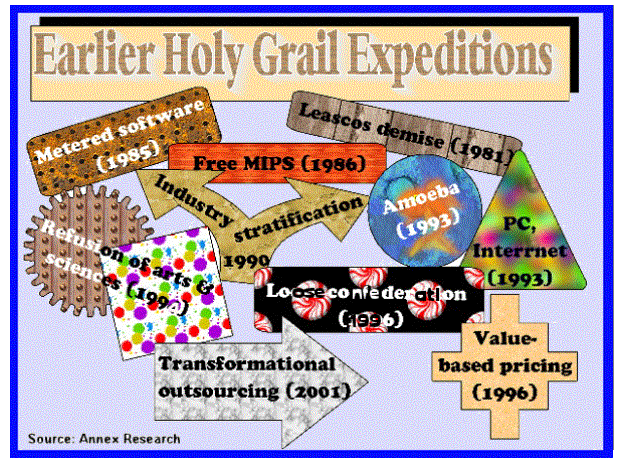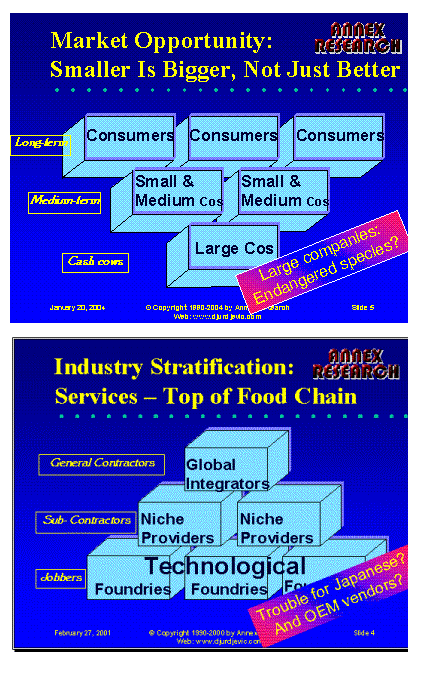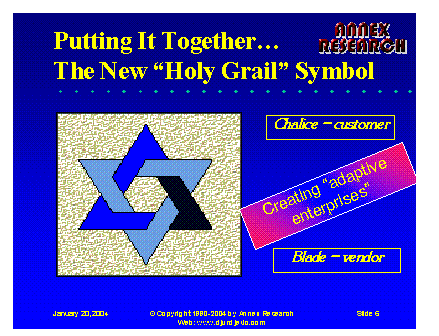
Home |
Headlines | Annex Bulletins
| Index 2004 | About
Founder | Search | Feedback
| Clips | Activism
| Client quotes | Workshop | Columns
| Subscribe ![]()
The copyright-protected information contained in the ANNEX BULLETINS and ANNEX NEWSFLASHES is part of the Comprehensive Market Service (CMS). It is intended for the exclusive use by those who have contracted for the entire CMS service.
An Open Client Edition
![]()
INDUSTRY TRENDS
Analysis of Current and Future Industry
Trends
IT Industry: Whither Goeth
It?
Latest Quest for “Holy Grail” to Spawn New “Kaleidoscopic” Enterprises and New CCOs (Chief Creative Officers)
PHOENIX, January 20 – Every so many years, computer industry gurus are asked to go search
for a new Holy Grail. Usually
that happens when the old guideposts outlive their usefulness, and the
marketplace gets as confusing and foggy to the client CEOs as is the view
of the world from the Foggy Bottom[1].
Well, we seem to be upon that time again.
“Quo vadis, IT industry?” (“IT
industry: whither goeth it?" - in antique English), are the questions
being asked by the CEOs today. And
as the computer companies’ staffs scurry around to come up with answers,
they inevitably turn to the computer industry gurus for help.
We’ve just returned from an assembly of some
of the industry’s finest minds. This
“think tank” ended up generating more fog that it started with.
To be sure, the conference lingo included plenty of
new jargon, such as “adaptive enterprise,” or “business agility,”
and even IBM’s “OnDemand” phrase (see “Different
Strokes for Different Folks, But
Same Old Storyline: "OnDemand" Is a New Name for an Old
Concept,”
Dec 2003). And it also used
some new acronyms, such as UDC (Utility Data Center).
But the discussion revealed that new terminology merely masked a
dearth of new concepts and clear ideas about the new Holy Grail.
So we decided we would attempt this latest Holy Grail quest, our 11th in 22 years, the way our most successful cerebral expeditions had been launched in the past– solo!

So what and where is the new Holy Grail?
As usual, it’s a combination of new and old.
As a famous German poet and writer Johann Wolfgang Goethe said, "the greatest genius will never be much if he pretends to draw
exclusively from his own resources. What
is a genius but the faculty of seizing and turning to account everything
that strikes us? Every one of
my writings has been furnished by a thousand different persons, a thousand
different things...."
So first, the old…
The
Old… (1)
Back in early 1981, we predicted that IBM would enter the leasing business, and suggested that independent lessors would
be doomed, unless they changed and adapted to a new, more competitive
marketplace.
enter the leasing business, and suggested that independent lessors would
be doomed, unless they changed and adapted to a new, more competitive
marketplace.
(2) Back in 1985, we said that a transfer of
value would be occurring – from hardware to software – and that some
form of “metered software” may follow (such as charging based
on EXCPs, an old mainframe term for input/output transactions).
(3) Back in 1986, as the IBM midrange 4300
series premiered, we reiterated the above, and added that in the long run,
this may lead to “free MIPS” – vendors giving away hardware
so as to collect revenues from software and services.
(4) Back in 1990, we said that stratification
would occur that would place IT services companies at the top of
the IT industry’s food chain (see “Industry
Stratification,” Mar 1990). Nearly
14 years later, we all know that has occurred.
We also said that the “best of breed”
customers would morph into a new breed of IT services vendors -
in conjunction and partnership with computer companies. That has not happened until now in any discernible way.
(5) Back in 1993, we likened a successful growing corporation to an amoeba that knows when to split in order to continue to grow (see Annex Bulletin 93-17, 3/19/93, on EDS).
We repeated that in 1995 in reference to IBM, offering work by Leopold
Kohr, an Austrian sociologist, in support of our theory:
Which says nothing about how good Gerstner & Co. will be in the art of architecting the new ‘new IBM’ - the main reason we applauded the choice of an outsider as IBM’s new CEO, in March 1993. Nor does it tell us much about how open-minded they will be to hire such missing talent from the outside, instead of protecting the turf on which they are comfortable - (re)engineering. Or if they’d be prepared to act as an amoeba, and split up when the size of an operation starts to get in the way (see Annex Bulletin 93-16, 3/18/93).
As the Austrian sociologist, Leopold Kohr, wrote in his 1957 book, ‘The Breakdown of Nations,’ (that’s right - 1957, not 1975!), ‘it is always bigness, and only bigness, which is the problem of existence - social, as well as physical.’ Kohr concluded that the only solution must lie in cutting down of the substances and organisms which have ‘outgrown their natural limits.’
Frankly, some recent
statements by the two top IBM executives, in which they sounded more like
army generals than artists, raised renewed questions about their
suitability to rebuild basically an early 20th century (Tom Watson)
creation, into a nimble and creative 21st century company."
(see
Annex
Bulletin 95-35, 4/27/95)
(6)
Back in 1994,
we likened the PC and the Internet revolutions to the
invention of a handgun. They empower
the individual and small companies to compete with industrial giants
on a level playing field.
(7) We also said that, as a result, a re-fusion
of arts and sciences would take place, returning man back to Leonardo
da Vinci’s era. Emphasizing
the same point at a meeting with senior IBM executives, we wondered if
perhaps “IBM had too many engineers and not enough musicians”
on its payroll? (see Annex
Bulletin 96-42).
(8) Back in 1996, we opined that circa 2010,
corporations would no longer resemble the entities we know today –
centrist, federalist entities created in the industrial era. We thought they’d be more like “loose
confederations,” changing their shape and alliances all the time
depending on the market opportunities.
We shared that vision in a private meeting
with the chief IBM strategist, Bruce Harreld, after
an IBM conference in Toronto, Canada:
He (Bruce Herald) agreed with our notion that the most successful “companies” of that era may in fact be the loose confederations of businesses and individuals.
“Many people don’t have a
clue about what we are now talking about,” he added.
“It’s the generation gap,” dividing the Fortune 500-type CEOs
into two groups. Those who
are in the 45 to 55 age bracket, generally understand the tectonic changes
taking place in the world economies.
But a 62-year old CEO doesn’t have a clue what this is about,”
he opined.
(from Annex
Bulletin 96-42, Aug 1996)
Well, the 55-year old CEOs from the time of
the above conversation are now 63, and probably working on their putting
game more than on corporate strategy.
But are the new CEOs who replaced them any wiser, any more
visionary and forward-looking, any more open-minded?
Not necessarily. After all, who do you suppose picked the successor?
And most people tend to pick the like-minded people, like Sam
Palmisano in IBM’s case (see “Sam
Is No Change Agent,” May 6, 2002).
As a result, there was not much evidence of change in substance and
strategy after two years of Palmisano’s leadership.
Some gurus think that, "what we are
seeing in big business is ‘strategy decay’."
That’s what a highly esteemed corporate strategy consultant, Gary
Hamel, said at a Boston conference four years ago.
“Buying back your own stock is what people
do who are bereft of ideas,” he added.
“It’s usually done in companies run by a 60-year old CEO
running his stock options to the bank.
If you can’t grow, buy back shares,” (see “Death
of The Corporation?”, July 1999).
Strategy decay? Can’t grow? Buy
back shares? Can you think of
a three-letter corporate acronym that epitomizes all three Hamel epithets?
Big Blue is actually a wonderful starting
point in a quest for a new Holy Grail.
For, it is both a provider and a consumer
of change. So if one
can figure out where IBM’s new Holy Grail is, the same “secret
recipe” for growth and success should work for other corporate giants. [To see our recipe for Big Blue is, check out “Save,
Spend and Split”
(May 8), our five-year forecast].
(9) Also back in 1996, Jim Cannavino, a former
IBM chief strategist and COO of Perot Systems at the time, first noted a
new IT services trend that he called “functional outsourcing.”
He pointed to Swiss Bank, a new Perot account back then, as an
example. Circa 2001, IBM and
EDS started using the term “business process outsourcing” (BPO)
in the same context, while Accenture called it “transformational
outsourcing.”
All three terms referred to a process of
creating building blocks that clients could use to design new
corporate structures and functions.
(10) Finally, also back in 1996, we said that
future pricing of IT services may be increasingly based on some form of
revenue sharing between the customer and the vendor (value-based
pricing). And we saw one
company already trying that concept out:
Andersen
(now known
as Accenture) also demonstrated another important
ingredient for global success - creativity.
The company started to use innovative “value based”
arrangements with some of its clients.
The services vendor’s compensation is linked to the value
it helped create for the clients, not the standard “time and
materials” fee structures.
For
the time being, this activity is still in its embryo, being tried only
with select established accounts. About
20% to 25% of the deals have some value-based pricing elements in
them, according to David Deal, Andersen’s manager for media and analyst relations.
(see
Annex Bulletin 96-13, Feb 1996)
Which brings us to…
The
New…
What’s really new on the current Holy Grail trail?
First, it is encouraging to see evidence of
some Fortune 500 CEOs opening up their minds and wallets to real change,
not just paying lip service to it. Twenty
of Hewlett Packard’s top 100 customers, for example, have asked for “agility
assessment” studies, said Ann Livermore, the head of HP Services and
Enterprise Systems, at a recent conference in Palo Alto, CA.
And “business agility” is a prelude to “adaptive
enterprises,” she explained.
“Adaptive enterprises?”
The term describes companies that are dynamically changing,
constantly evolving, just like our 1993 amoebas, or
images in a kaleidoscope – thus our term “kaleidoscope enterprises.”
dynamically changing,
constantly evolving, just like our 1993 amoebas, or
images in a kaleidoscope – thus our term “kaleidoscope enterprises.”
The fact that one in five large company CEOs
is now even contemplating such “radical” notions is nothing short of
revolutionary. That’s
especially true given what IBM’s Harreld noted about
the Fortune 500 CEOs’ mindsets eight years ago.
What’s the reason for such a dramatic change
in eight years? Competitive
pressures, and not just from their struggling peer-giants, but even more
so from new competitors – the individuals and small companies that we
talked back in 1994, about being empowered in the new IT era.
As a result, these shrinking giants are being
forced to reinvent themselves if they are to survive in the new world of
the more nimble 21st century competitors. Enter “adaptive enterprises.”
So how goes it? How are they adapting?
Not so great, it would appear, based on what
we heard at the recent “think tank.”
The concept sounds great in theory, but in practice companies are
finding that the “devil is in the details.”
In part, that’s because technologists with industrial era
mindsets, not freethinking artists, are leading the transformation
process. If the end result is
to be a “dynamically changing, constantly evolving” enterprise, it
will take both technology (to create tools) creative minds (to use them).
The successful process, as we see it, is
analogous to creating a painting or a sculpture. The IT services vendor brings to the table his toolkit and
paints. The toolkit consists
of various building blocks, along with instructions on how to use them.
Just as software development, for example, evolved from writing
individual lines of code, to using macros and icons and applets to speed
up the creative process, so will the creation of new corporate forms –
using the various IT building blocks.
The IT services vendor also teaches the client
how to use his tools and paints and brushes. Together with the client, he designs a kaleidoscope of shapes
that the client CEO wants his “adaptive enterprise” to take, depending
on the needs of the marketplace.
So the search for the new Holy Grail – a key
to creating successful “adaptive enterprises” - is a bipolar process.
Like procreation, it
takes a union of Ñ (chalice – woman - client) and a D (spade – man - vendor)[2]
to make it work. The chalice
is the marketplace (customer), the spade is the IT provider (vendor).
Back in 1990, we depicted the new world of IT vendors circa 2000 as a pyramid (or a blade, see the bottom chart – “Industry Stratification”).

Back in 1996, we advocated that smaller is
not only better, but also bigger, when it comes to market opportunity.
And we depicted it as an inverted pyramid (or a chalice, see the
top chart – “Market Opportunity”).
Bruce Harreld, IBM’s chief strategist, said that more than 50% of the 1996 IT revenue opportunity lies in the small and medium companies market, which is growing at 14% to 15% per year, i.e., almost double the growth rates of the industry.
“Technology
is allowing these guys to compete with the big boys in their
industries,” Harreld explained.
(from
Annex
Bulletin 96-42, Aug 1996)
New Life… Now, putting the two charts and concepts together, the intertwined chalice and blade, woman and man, customer and vendor, symbolize the bipolar nature of creating a new life form – the “adaptive enterprise.” The two pyramids, tightly interwoven, symbolize the IT industry’s new Holy Grail[3] (see the chart, keeping in mind that any similarity with the Star of David is coincidental). The symbol depicts the customer and the vendor as equal partners in procreation; the mother and the father of a new “adaptive enterprise,” their joint brainchild.

From our vantage point, it is the only way
corporate America may survive the onslaught of more nimble competitors,
both domestic and from overseas. It
is it’s the only hope for its resurrection and eventual rebirth
as an “adaptive enterprise.” It’s
either change and adapt by partnering with IT services companies, or go
the way of dinosaurs… sooner or later.
Change or perish
- is a very powerful sales message that IT services vendors could be delivering to their customers’ CEOs, but aren’t, to
the best of our knowledge. Or
at least not forcefully enough. If
they were, there ought to be 80 of 100 customers clamoring for “agility
assessments,” not just 20.
vendors could be delivering to their customers’ CEOs, but aren’t, to
the best of our knowledge. Or
at least not forcefully enough. If
they were, there ought to be 80 of 100 customers clamoring for “agility
assessments,” not just 20.
New
Roles…
The new IT industry’s Holy Grail obviously also requires some radical
changes in the traditional roles and strategies of the IT services
vendors. They must morph in
their self-perceptions from being providers of specific non-essential
tasks (such as running data centers), to being providers of life and
fortune, like the owners of the thoroughbred studs who can sire the
customer’s mares. (Of
course, they’d better make sure first that they have thoroughbred studs
in their stables, rather than parade ponies).
In short, the IT services vendors are now the quintessential "change agents."
New Metrics… New roles require new metrics, too, meaning new ways of measuring and
charging for value created. No
longer should the IT services vendors allow themselves to be on the mercy
of the customers’ “overheads” or expense budgets; not when nothing
less that the client’s survival is at stake.
As equal partners in procreating and parenting the new “adaptive
enterprises,” the IT services vendors have the right to demand and to
expect commensurate shares of the revenues and profits that the corporate
newborns generate.
As you’ve seen before, that’s not a brand new idea. Some IT services vendors and we been talking about the “value-based pricing” and revenue sharing for at least eight years now. But the time has now come for theory to become a reality. All it takes is vision and courage.
And what if a customer balks? That’s
okay, too. Dinosaurs also
failed to change. So the IT vendors
may want to have their sales people leave a (duly authorized) copy of this
article, along with their business cards.
Maybe some CEOs will change their minds over time, as they get
tired of swimming in alligators.
New
Terms…
New roles and new metrics of the IT services providers also require new
terms that describe them.
“Outsourcing,” for example, should be
abandoned as an outdated type of business relationship.
Outsourcing implies that the customer turns over the responsibility
for running its IT to a vendor, and then just yells at him if something
goes wrong. As a parent of a
new “adaptive enterprise,” the customer (mother) has a joint
custody of the infant with the vendor (father).
Both are responsible for its well-being.
Both should share in risks and benefits of its upbringing.
New
Jobs…
Finally, creating new “adaptive enterprises” takes creative people at the helms of enterprises.
As far as we know, creativity has never been high on the list of
prerequisites for a Fortune 500 CEO.
Maybe it ought to be (we think so), but the reality is that it
hasn’t been.
creative people at the helms of enterprises.
As far as we know, creativity has never been high on the list of
prerequisites for a Fortune 500 CEO.
Maybe it ought to be (we think so), but the reality is that it
hasn’t been.
So rather than wait for the corporate Boards
to wake up and start replacing the complacent old-school CEOs with fresh
new and creative blood, the Fortune 500 CEOs should be encouraged to take
a proactive role and save their jobs – by creating a position of Chief
Creative Officer (CCO), a corporate artist of sorts (even if the term
sounds like an oxymoron).
The CCO would play the role of the virtual
mother in procreation of the “adaptive enterprise,” partnering with the
corresponding number at the IT services company (the virtual father).
The CCO should report directly to the CEO and have the power to cut
through the bureaucratic webs that tie his corporation to the old legacy
systems and habits.
Summary
As we’ve also noted 10 years ago, the PC
revolution and the Internet are returning man back to nature, paving the
way for a re-fusion of arts and sciences.
The new CCO position would embody that concept and extend it even
to the corporate world.
Happy
bargain hunting!Bob Djurdjevic
[1] Foggy Bottom is the low-lying area of Washington, DC, where the State Department is located.
[2] Borrowing the terms from Dan Brown’s “Da Vinci Code” book.
[3] The Holy Grail term is used in this context metaphorically to describe the key to future survival and eventual rebirth of corporate America.
![]()
For additional Annex Research reports, check out...
2003 Global: "A Passage to India" (July 22); "Exodus from Equities" (May 27), "Money CAN Buy Longer Life" (May 6), "Global Investments Plummet" (Jan 23)
A selection from prior year
s (Global): Greed Bites Back (Nov 29, 2002), Salomon/Gutfreund: Wall Street Casino (June 21, 2002), "From a Nation of Producers, to a Nation of Gamblers " (June 23, 1999), "When Will Wall Street's Bubble Burst?" (1998), "Wall St.'s Conquest of America" (1998), THE GREAT AMERICAN HOOVER (1997)2004 IBM: "Hype Exceeds Results" (Jan 15)
2003
IBM: "Small Is Now Big at Big Blue" (Oct 15); "A Passage to India" (July 22), “On the Nose But No Cigar” (July 16), “A Paler Shade of Blue” (June 2), “Save, Spend and Split” (May 8), “Shrunk by the Marketplace” (Apr 17), “Turnaround Continues...” (Apr 15), “Start of a Real Turnaround?” (Jan 17).2002 IGS: "Half or Double Trouble?" (Aug. 12, 2002), "IBM to Take $500M Charge" (Sep 3, 2002), IBM-PwCC Update (Oct 2, 2002), Analysis of IBM Second Quarter Results (July 17, 2002), IBM Layoffs Confirmed! (Aug 14, 2002), Analysis of IBM Third Quarter Results (Oct 16, 2002), Boom Amid Gloom and Doom (Oct 10, 2002)
2002 IBM: “Gerstner: The Untold Story” (Dec 27), "Gerstner Spills the Beans" (Dec 13), "On a Wing and a Prayer" (Oct 21), "IBM-PwC Tie the Knot" (Oct 2), "Half or Double Trouble?" (Aug 12), Wall Street/Main Street Chasm (June 25), “Wall Street Casino,” (June 21), Big Blue Salami (June 19), "Looming IBM Layoffs" (May 14), "IBM 5-Yr Forecast: From Here to Eternity?" (Apr 2002), “Tough Times, Soft Deals,” (Apr 25, 2002), “Gerstner’s Legacy: Good Manager, Poor Entrepreneur” (Jan 2002), IBM Pension Plan Vapors: Where Did $17 Billion Go? (Mar 2002), "Sir Lou OutLayed Lay!" (Apr 1, 2002).
A selection from prior years
(IBM): Is IBM Cheating on Taxes, Annex Bulletin 99-17 (May 1999), IBM 5-year Forecast 2001: An Unenviable Legacy (June 2001), "Break Up IBM!" (Mar. 1996), Fortune on IBM (June 15, 2000), “Smoke and Mirrors Galore,” July 2000), "Slam Dunk of Bunk" (Jan 2000), Annex Bulletin 98-14 ("Wag the Big Blue Dog"), Armonk's Fudge Factory (Apr. 9, 1999), Where Armonk Meets Wall Street, Greed Breeds Incest (November 1998), Stock Buybacks Questioned: Is IBM Mortgaging Its Future Again?, 97-18 (4/29/97), "Some Insiders Cashed In On IBM Stock's Rise, Buybacks" 97-22, 7/27/97, Djurdjevic’s Forbes column, "Is Big Blue Back?," 6/10/97; “Executive Suite: How Sweet!,” (July 1997), "Gerstner: Best Years Are Behind", Aug. 10, 1999), "IBM's Best Years Are 3-4 Decades Behind Us" (July 1999), "Lou's Lair vs. Bill's Loft" (June 1999), "Corporate Cabbage Patch Dolls," 98-39, 10/31/98; Djurdjevic’s Chronicles magazine October 1998 column, "Wall Street Boom; Main Street Doom", “Louis XIX of Armonk,” (Aug. 1996), "Mountain Shook, Mouse Was Born" (Mar. 25, 1994), “A Nice Guy Who Lost His Compass” (Jan 26, 1993), “Akers: The Last Emperor?” June 1991), Industry Stratification Trend (Mar. 30, 1990), etc.]![]()
Or just click on  and use appropriate
keywords.
and use appropriate
keywords.
Volume XX, Annex Bulletin 2004-02 Bob Djurdjevic, Editor P.O. Box 97100, Phoenix, Arizona
85060-7100 |
![]()
Home | Headlines | Annex Bulletins | Index 2004 | About Founder | Search | Feedback | Clips | Activism | Client quotes | Workshop | Columns | Subscribe